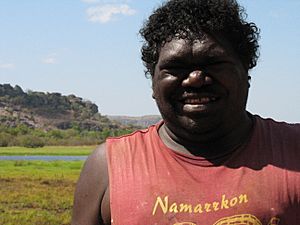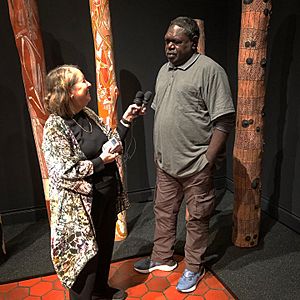Gabriel Maralngurra facts for kids
Quick facts for kids
Gabriel Maralngurra
|
|
|---|---|
 |
|
| Born | 1968 Gunbalanya, Northern Territory, Australia
|
| Nationality | Australian |
| Organization | Injalak Arts |
| Known for | Painting, Contemporary Indigenous Australian art |
| Spouse(s) | June Nadjamerrek |
| Children | Gabriella Maralngurra (daughter), Maath Maralngurra (son) |
| Parent(s) | William Maralngurra, Dolly Maralngurra |
Gabriel Maralngurra (born 1968) is a famous Aboriginal artist. He belongs to the Ngalangbali clan of the Kunwinjku people in West Arnhem Land, Australia. Gabriel is well-known and respected in his community for his many important roles. His amazing artwork is shown in museums around the world, like the Australian Museum and the Kluge-Ruhe Aboriginal Art Collection in the United States.
Contents
Early Life and Influences
Gabriel Maralngurra was born in Kunbarlanja and is the oldest of seven children. His father, William Maralngurra, taught him important stories from the Dreaming. In Aboriginal Australian cultures, the Dreaming explains how life began, important cultural values, and laws. These ancient stories, passed down through his family, have greatly inspired his art.
Artistic Career and Style
Gabriel Maralngurra is known for using natural earth pigments called ochre on paper. He keeps the traditional ways of rock art alive while also adding new and creative techniques. His paintings often show a wide range of subjects, from old stories to animals and plants. He uses smooth lines and original designs.
Many of his paintings aim to help people from other cultures understand and appreciate Aboriginal culture. The Kunwinjku people's art from Western Arnhem Land is strongly influenced by the ancient rock art of their area. Gabriel's art helps make sure that the tradition of painting in Arnhem Land continues for younger generations. He shares his culture's stories and practices by showing his connection to the natural world.
One of Gabriel's biggest achievements was helping to start Injalak Arts in the 1980s. Injalak Hill is a popular place for visitors because of its rock art, which is thousands of years old. One special rock painting there is called the "Buffaroo." It mixes a traditional kangaroo shape with a new animal, the water buffalo, which was brought to the area. This painting shows how Aboriginal artists experimented with new ideas.
Gabriel's paintings are inspired by these traditional rock art images. He often paints local animals, spirit figures like the Mimih spirit, and Dreaming stories (called djang). He always adds his own special touch to make his art unique to Arnhem Land.
This new way of painting, which looks like ancient rock art, is called "rock art style." It combines old traditions with new methods, like printing on paper and using modern colors. Gabriel does this because he wants to create new art and share his work with people all over the world.
Gabriel learned many of his painting skills from his elder, Thompson Yulidjirri. Thompson taught him techniques like x-ray (showing internal organs) and rarrk (cross-hatching). These techniques help Gabriel combine old and new ways to make his community stronger.
His paintings often show how different animals are hunted and cooked. He paints animals like pythons, spoonbills, echidna, turtles, and geckos. Through these paintings, Gabriel also shares cultural details, like how some groups eat certain animals while others do not.
Contact Paintings
Between 2004 and 2007, Gabriel Maralngurra created a series of "contact paintings." These artworks explored historical events, like when anthropologists and missionaries first arrived in Gunbalanya. These paintings show how different cultures met and how they were different. Gabriel used these paintings to teach others and bridge gaps between communities.
He especially focused on Walter Baldwin Spencer, who was one of the first anthropologists to visit Western Arnhem Land. In 2003, Gabriel showed his first painting of Baldwin Spencer. It showed Spencer meeting an Aboriginal man, surrounded by objects from both their cultures. This painting highlighted the challenges of communication and exchange between visitors and local people.
Gabriel's art is displayed in many collections, including the Australian Museum and the Kluge-Ruhe Aboriginal Art Collection in the United States. Some of his famous contact paintings include Meeting of Bininj Elders and Balanda Visitors in 1948 and Baldwin Spencer and Paddy Cahill. Many of these were shown at his solo exhibition, Contact, in Melbourne in 2006.
Charlottesville Exhibition
In January 2020, Gabriel Maralngurra visited the University of Virginia in Charlottesville, USA. He and fellow artist Joe Guymala shared their artworks and talked about their culture. This big exhibition featured over 50 artists and 200 pieces across five locations in the city.
The Kluge-Ruhe Aboriginal Art Collection in Charlottesville is a major center for Aboriginal art. It has over 2000 pieces and invites Aboriginal artists each year to visit, lead workshops, and teach students.
Gabriel played a big part in the exhibition at The Fralin Museum of Art, called The Inside World: Contemporary Aboriginal Australian Memorial Poles. This show featured 112 memorial poles by 55 different artists from Arnhem Land. Gabriel helped by painting one of the poles and creating a painting for Jefferson's Rotunda.
The memorial poles are hollow logs decorated with special designs. They represent the moment when a person's spirit returns home after they pass away. Gabriel contributed to a group of six memorial poles from his region. These poles were made from wood and painted with earth pigments, showing images like the Mimih spirit. The art is not just in the painting, but also in the difficult process of finding and preparing the logs. Gabriel explained that bringing this art to Charlottesville was a way to share and promote their strong culture from far away.
Gabriel also displayed a "rock art style" piece called "Kunwardde Bim Kakukyime" in the Rotunda. This painting shows how he uses local figures like the brolga bird and the Mimih spirit to connect his art to his land and people. Kunwardde Bim Kakukyime shows many overlapping animals from his region in shades of red, white, yellow, and blue. The brolga, a bird that is a hunting prize, is painted in x-ray style, showing its bones and organs. This shows his deep connection to the animals of his land. In the corner, he included a Mimih Spirit, which is believed to have taught his people important survival skills like hunting. This artwork uses many figures and colors to show the unique identity of his community.
Other Roles
Besides being an artist, Gabriel Maralngurra is also a tour guide, a translator, and a board member and president of Injalak Hill. He has traveled widely in Australia and overseas for over twenty-five years, sharing his culture.
Awards
- 2006: Best Indigenous Artist at the Melbourne Fringe Festival
- 2010: Telstra Indigenous Art Awards - Highly Commended for "Wurdwurd (children) Kudjekbinj Dreaming"
Collections
Gabriel Maralngurra's artworks are held in many important collections, including:
- National Museum of Australia
- Department of Foreign Affairs, Canberra
- Museum and Art Gallery of the Northern Territory
- Museum Victoria
- Batchelor Institute, N.T.
- Berndt Museum of Anthropology, University of Western Australia
- Kluge-Ruhe Aboriginal Art Collection of the University of Virginia
Significant Exhibitions
Gabriel Maralngurra's art has been shown in many exhibitions around the world. Some notable ones include:
- 2020: Munguyhmunguyh (Forever): Celebrating the 30th Anniversary of the John W. Kluge Injalak Commission, at The Rotunda at the University of Virginia
- 2019-2020: The Inside World: Contemporary Aboriginal Australian Memorial Poles, shown at several museums including the Nevada Museum of Art and The Fralin Museum of Art at the University of Virginia.
- 2006: Making Contact. Solo Exhibition. Mossenson Galleries, Melbourne.


